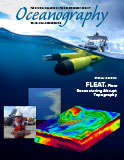Article Abstract
This article presents a pedagogical approach toward understanding vorticity generated in flow past an island. The ubiquity of eddies in the ocean motivates the use of vorticity to quantify their rotation, and we define two kinds of vorticity: relative vorticity, that is, the vorticity of an eddy relative to Earth, and planetary vorticity, Earth’s spin relative to local vertical. The ratio of relative to planetary vorticity is the Rossby number, Ro, a useful normalized measure of vorticity. Vorticity may be created in flow past an island as the alongshore current at the coast is forced to zero by friction. Observations from the Flow Encountering Abrupt Topography (FLEAT) program, including those from satellites, underwater gliders, ship surveys, and moorings, are used to measure vorticity as forced when the North Equatorial Current collides with the northern tip of Palau. The observations include time means over years, with Ro about 0.3 at horizontal length scales of tens of kilometers and snapshots of Ro as large as 30 from eddies of diameter 1 km. Vorticity can be broad-banded in time, with strong westward flow causing vorticity at frequencies as high as semidiurnal. Implications of this wide range of scales in vorticity are discussed in the conclusion.

